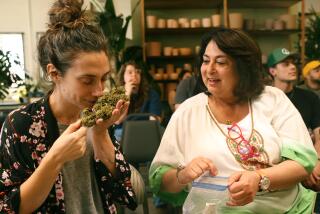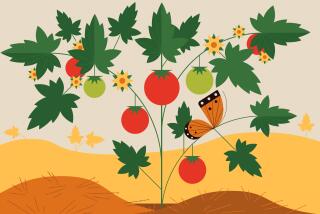Variety Is Spice for Southland Tomato Lovers
- Share via
For the past 15 years the tomato has remained the most popular vegetable among home gardeners in this country. And for the past 35 years, the tomato has been my favorite garden inhabitant. Indeed, my love of the tomato has led me to sample more than 250 different tomato varieties in my Southern California garden.
Here are some observations gleaned from those 35 years that may be helpful when planning your tomato patch.
First, let’s put a widely held myth to rest: “Modern tomato varieties just don’t taste as good as the old-fashioned tomatoes.”
I don’t buy that argument. In my opinion, there are a number of modern varieties that have excellent flavor. Perhaps because of a bit of nostalgia, I devoted a section of my garden three years ago to old-fashioned tomato varieties. Some of these heirloom tomatoes were popular in home and market gardens in the early 1900s.
The Big Winners
In taste tests among friends, where the samples were not labeled, the modern Better Boy and Supersteak tomatoes proved to be the big winners. One oldie, however, Bonnie Best, received rave comments.
In addition, three years ago in The Times, I reported on a tomato taste-off, featuring prominent Los Angeles area chefs and food experts, where two modern hybrids, President and Sweet 100, rated tops.
Tomato variety does play an important part in successful tomato growing. For instance, some Southland growing regions have a soil that is infested with verticillium or fusarium wilts or nematodes. If you suspect your soil might have these problems, or if you don’t know if it does or not, stick to varieties whose names on the plant labels are followed by the initials V, F, N, such as Better Boy VFN. The initials signify a tolerance or resistance to the above tomato problems.
Variety also plays an important role in fruit production and in garden space requirements. Expect much heavier fruit production among the modern hybrids. For instance, the old Beefsteak variety will produce about 10 to 15 large fruit per plant, while its modern counterpart, Supersteak Hybrid, will yield 50 or more large fruit. Sweet 100 cherry tomato will bear more than 1,000 fruit per plant.
As to garden space, tomato varieties labeled “indeterminate” have large, sprawling plant habits and require staking or very large tomato cages. Those labeled “determinate” are compact plants that require much less garden space and fit easily into medium-size cages. Varieties labeled “semi-determinate” have larger plant habits than determinate types but lack the sprawling characteristics of indeterminate varieties.
You can save six weeks of growing time by purchasing tomato bedding plants at nurseries and transplanting them into your garden. On the other hand, you can sample more varieties by starting your own transplants from seed. In the past few years, bedding plant growers have been stocking local nurseries with a much wider selection of quality tomato varieties than previously made available (please see bedding plant selections at the end of this article).
To make your tomato growing experience more enjoyable, you may want to stretch your harvest season by planting at least one early tomato variety (such as Early Girl), one mid-season type (Celebrity would be a good choice) and one late-season tomato (such as Supersteak).
As to planting and culture, by following the cultural practices outlined here, you should experience a good measure of success with your tomato patch.
Seven Hours of Sun
Choose an area of the garden that receives at least seven hours of sun daily--the more the better. Work generous quantities of organic material into the soil. If the soil tends to be alkaline, as much of the soil in the Southland is, peat moss is a valuable organic addition. When working the soil, add a vegetable fertilizer, following label instructions as to amount. Water the soil thoroughly and allow it to settle for two days before planting.
Transplant the young plants into the garden in late afternoon when they will have the cool of the evening to recover from the transplant shock.
Remove the plants from the container, leaving an equal amount of soil and root system on each plant. Planting holes should be 2 to 3 feet apart and should be deep, with the plants set at a deeper level than they were in the container. Remove the lower leaves along the stem and bury the plant to within 2 to 3 inches of its top-most foliage. The buried section of the stem will develop roots, thereby strengthening the plants.
During the transplanting process, water the plants gently with a sprinkling can. For the first five days after transplanting, give the plants a light watering once a day.
You will save space and have cleaner fruit if you give your tomatoes support. To avoid disturbing roots at a later date, put stakes or cages in place right after the transplanting process.
When young plants are established, water deeply on a weekly basis (tomatoes grown in containers need far more frequent watering). After the plants begin to set fruit, it will pay you to sprinkle some vegetable fertilizer around them on a monthly basis. Always water thoroughly after fertilizing.
Spreading black plastic mulch between plants eliminates weeding and speeds up growth. Always put drainage slits in the plastic so water can get through. Control those big ugly tomato worms by using Dipel, Attack or Thuricide, which are biological controls that are not harmful to beneficial insects. Spray every 10 days and follow the label instructions.
Bedding Plant
Winners and Losers
The following tomato varieties are widely available as bedding plants in Southern California nurseries and garden centers. Some are real winners and others are mediocre at best.
Winners
Better Boy--Probably the most foolproof tomato ever developed. Big, rugged hybrid plants produce large, delicious fruit in abundance. Indeterminate grower.
Celebrity--A recent All-America Selections winner, which produces large quantities of picture-perfect fruit with fine flavor. It’s very well-suited to most Southern California climatic zones. Vigorous plants are very disease-resistant. Semi-determinant.
Champion--High-quality fruit is borne on medium-size, manageable plants. Will produce over a long period. Great adaptability to Southland growing conditions. Indeterminate but very manageable.
Supersteak--If you grow Supersteak, you will never again grow the old-fashioned “Beefsteak” variety. Huge fruit, weighing up to 2 pounds, with wonderful flavor and texture; the plants are very large. Indeterminate.
Early Girl--This is the earliest-maturing standard-size tomato. Although it is not as disease-resistant as others, it has fine flavor. Figure 55 to 60 days to harvest after setting out transplants. Indeterminate.
Sweet 100--This is an immensely productive cherry-type tomato with a unique, sweet flavor. Expect up to 1,000 fruit on large, sprawling plants. Indeterminate.
Floramerica--Is another productive, rugged hybrid. Large, good quality fruit are produced on compact, easily controllable plants. Determinate.
Losers
Pearson Improved--This old-timer apparently has a following in the Southland because the plants keep appearing each year in nurseries. Bred originally as a commercial shipping variety, the fruit has a bland flavor and a watery texture. Indeterminate.
Beefsteak--Produces large fruit but in small numbers. Production is spotty and plants have no disease resistance. Gardeners who prefer large tomatoes are much better off with Supersteak or Beefmaster Hybrid. Indeterminate.
Patio--Bred for container or small-space gardening, This is usually the only container tomato available in nurseries as a bedding plant. It is better than nothing, but it is late to produce fruit and has a relatively short bearing period. Pixie and Patio Pride are better selections for medium-size containers, and Better Bush is superior for large containers. Perhaps someday the bedding plant growers will supply nurseries with these varieties. Right now, they can only be grown from seed. Determinate.
Cherry--Highly productive and grows like a weed, however, the fruit quality is inferior to the new Sweet 100 cherry tomato. Indeterminate.






